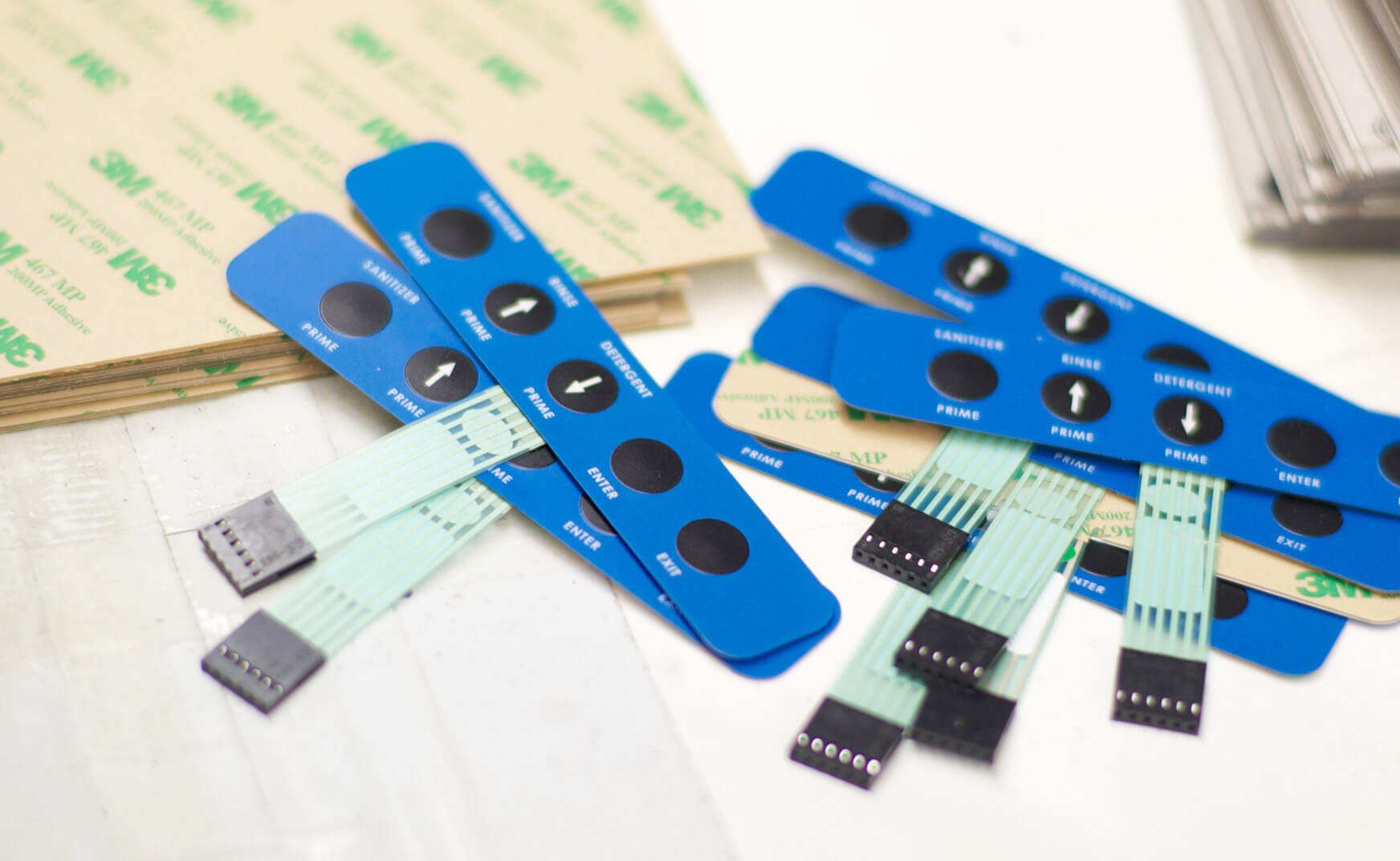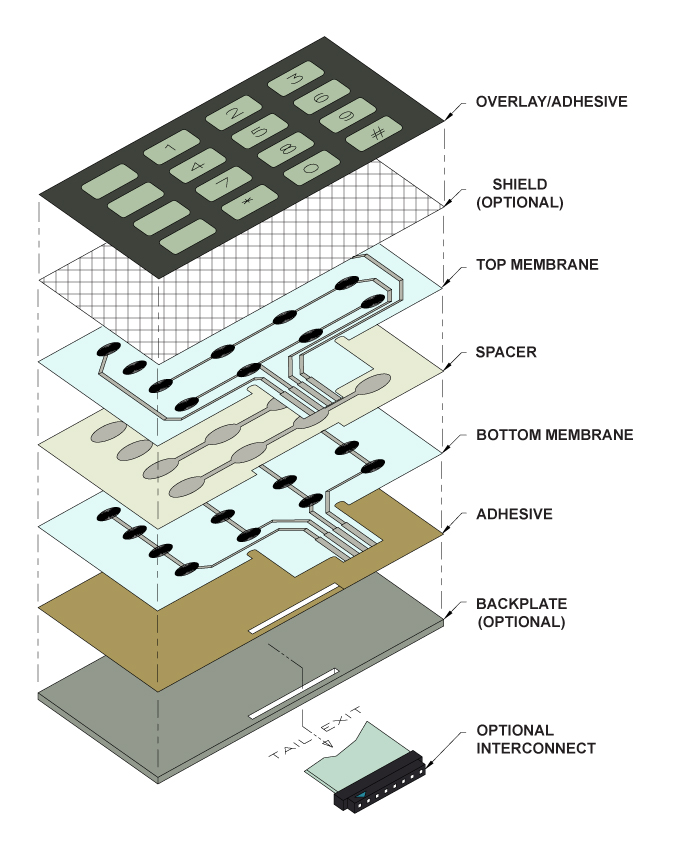What to Seek When Selecting a Membrane Layer Switch for Your Task
When you're picking a membrane layer button for your project, several essential aspects come into play. You'll need to believe about the products, design, and just how well it lines up with your brand name.
Comprehending Membrane Layer Change Parts
When you plunge into the world of membrane layer buttons, it's vital to understand the crucial elements that make them operate. The switch typically includes three main layers: the visuals overlay, the spacer layer, and the circuit layer. The graphic overlay provides the visual user interface, displaying switches and signs you need for very easy navigating. Below that, the spacer layer warranties there suffices range in between the circuit and the overlay, enabling the switch to trigger without constant pressure.
The circuit layer, typically made from published conductive inks, creates the electrical paths. When you push a switch, the circuit closes, sending out a signal to the device. Comprehending how these layers function together aids you select a membrane layer switch that's trusted and fits your job requirements. Pay very close attention to the density and product of each layer, as these aspects influence durability and functionality in different settings.
Material Selection and Its Effect
Picking the right materials for your membrane button can considerably influence its efficiency and long life. The selection of substrate, normally polyester or polycarbonate, affects longevity and flexibility. Polyester is much more abrasion-resistant, while polycarbonate uses much better clearness and toughness.
Following, take into consideration the adhesive. It requires to stand up to ecological factors like moisture and temperature changes. A solid sticky assurances that your membrane switch stays intact in time.
Don't ignore the visuals overlay. The printing technique used, whether silkscreen or digital, impacts the switch's appearances and long life. High-grade inks will stand up to fading and scratching, keeping an expert appearance.
Lastly, consider environmental conditions. If your device will certainly be subjected to rough chemicals or extreme temperatures, choose materials made to sustain these challenges. Your choices in products will ultimately establish the button's dependability and user complete satisfaction.
Design Factors To Consider for Individual Experience
Choosing the best materials lays the structure for a successful membrane button, however the style also plays a significant duty in individual experience. You'll wish to assess just how the layout influences use (membrane switch manufacturer). Keep switches and icons instinctive and well-spaced, making it easy for customers to navigate without complication

Shade and comparison are likewise vital; assurance that your layout is visually attractive however still useful. High contrast assists users conveniently identify buttons, particularly in low-light problems.
Lastly, show on the total visual. A smooth and modern-day design can elevate individual assumption and make your product much more enticing. Stabilizing performance with an engaging design will cause a far better individual experience and inevitably, a more effective item.

Environmental Elements and Resilience
When picking a membrane switch, you need to consider how it'll do in different settings. Factors like temperature resistance, wetness and chemical exposure, and mechanical wear can significantly influence its durability. Understanding these elements will certainly assist you pick a button that takes on your certain problems.
Temperature Resistance Requirements
As ecological problems can vary commonly, comprehending temperature level resistance is important for making certain the durability of your membrane layer switch. Make sure to inspect the specifications of the products utilized in the switch, like the sticky and overlay, as they straight influence performance. By picking a membrane switch with ample temperature level resistance, you'll improve its lifespan and preserve performance in tough environments.

Moisture and Chemical Direct Exposure
Moisture and chemical exposure can considerably affect the performance and durability of your membrane layer switch, so it's important to comprehend the setting in which it will be used. Always speak with the maker's requirements for chemical compatibility to assure your membrane layer button keeps its functionality over time. By focusing on wetness and chemical resistance, you can enhance the resilience of your switch in difficult environments.
Mechanical Damage
While you might prioritize attributes like aesthetic appeals and capability in your membrane button, mechanical wear and tear can substantially affect its efficiency over time. Frequent pressing can lead to degradation of products, creating problems like responsive comments loss or even switch over failing. Picking a sturdy switch assurances durability and dependability, avoiding expensive replacements and downtime in your task.
Customization Options for Branding
When it comes to branding your membrane button, personalization alternatives are vital. You can select style elements and shades that reflect your brand, along with particular logo placement and size to improve exposure. Additionally, selecting the appropriate materials and structures can elevate the overall feel and look, making your item attract attention.
Design Elements and Colors
A vast range of style components and shades can make your membrane layer switch not simply useful however likewise aesthetically enticing, boosting your brand identity. Do not fail to remember concerning structures; adding a tactile element can enhance individual experience and make your switch stand out. By thoughtfully pop over here choosing style components and colors, you not just create an item that looks excellent however additionally strengthens your branding consistently and successfully.
Logo Design Placement and Dimension
After completing your style elements and shades, the next action is to concentrate on logo placement and size. Your logo design is an essential element of your branding, so you'll want it to attract attention without frustrating various other design elements. Assess where your logo design will be most noticeable and impactful; usual placements include the top or center of the button.
Don't forget to contemplate exactly how the logo aligns with user communication. This focus to information will certainly improve both capability and brand identification in your project.
Material and Appearance Choices
Selecting the ideal materials and structures for your membrane switch can significantly improve both its performance and visual allure. You'll wish to evaluate options like polyester or polycarbonate, as they use longevity and resistance to use. The texture of the surface area also plays a necessary function; smooth surfaces provide a streamlined look, while textured surface areas can improve grasp and tactile comments.
Personalizing the materials and appearances allows you to reflect your brand identification successfully. You could select a matte coating to communicate sophistication or a shiny appearance for a contemporary touch. Do not ignore shade options, as lively colors can make your switch attract attention, while soft tones can develop a more classy look
Price vs. High Quality: Locating the Right Equilibrium
When you're handling the alternatives for membrane switches, balancing price and quality can feel frustrating. You desire to ensure that you're getting a reliable product without damaging the bank. Start by identifying your job's details demands. Are you focusing on resilience or appearances? A lower-cost switch might conserve you money upfront, but if it jeopardizes performance, you might face greater substitute expenses later on.
Search for makers that supply a good mix of affordability and high standards. Research their reputation and client evaluations to assess dependability. Occasionally, investing a bit a lot more in top quality over at this website products can save you from future headaches.
Also, consider the lasting efficiency and warranty choices. A slightly more pricey button with a strong service warranty might prove to be a smarter investment. Eventually, it has to do with discovering that wonderful place where you fulfill your spending plan while assuring your job's success.
Testing and Quality Control Protocols
While you might locate the best membrane switch style, guaranteeing its top quality through strenuous screening protocols is vital for long-lasting success. Beginning by confirming that the producer follows market standards, such as IPC/WHMA-A -620, to ensure a dependable product. membrane switch manufacturer. You'll desire to examine for detailed testing methods, including environmental, mechanical, and electric analyses
Ensure the switches go through resilience screening, mimicing real-world usage to recognize any possible failures. Pay focus to the manufacturer's top quality guarantee procedure, which should include normal evaluations and audits.

Do not neglect to request examples and conduct your own examinations to confirm compatibility with your job. Take into consideration how typically the manufacturer updates their methods; advancement in screening can lead to better high quality. By prioritizing these screening and quality control methods, you'll raise the probability of a successful and long lasting membrane layer switch for your application.
Regularly Asked Questions
The length of time Does a Membrane Layer Switch Commonly Last?
A membrane button typically lasts anywhere from 1 to 10 million cycles, depending upon use and environmental variables. You'll desire to consider your details demands to guarantee it satisfies your longevity demands properly.
Can Membrane Layer Switches Over Be Fixed if Damaged?
Yes, you can sometimes fix membrane layer switches if they're harmed, however it typically depends upon the degree of the damage. Small concerns could be reparable, while a lot more considerable damages usually needs substitute for appropriate functionality.
What Are the Usual Applications for Membrane Switches?
Membrane layer buttons are frequently utilized in appliances, medical devices, and auto controls. You'll discover them in consumer electronic devices, commercial equipment, and also video gaming consoles. Their flexibility makes them suitable for various individual interfaces click here for info and environments.
Are There Specific Certifications for Membrane Layer Switches?
Yes, there are particular accreditations for membrane layer buttons. Search for UL, CE, and RoHS accreditations to assure safety and security and conformity. These accreditations show the switch satisfies market criteria for high quality and environmental safety and security.
Exactly how Do I Guarantee Correct Installation of a Membrane Switch Over?
To guarantee correct setup of a membrane switch, tidy the surface area completely, straighten it thoroughly, and apply also pressure. Comply with manufacturer guidelines for sticky curing time to make the most of resilience and functionality.
Final thought
When choosing a membrane button for your project, maintain these vital aspects in mind: focus on sturdy products, concentrate on straightforward design, and think about personalization for your brand. Balance expense and quality by looking into trustworthy suppliers with strong quality control methods. By thoroughly assessing these facets, you'll ensure your membrane button not only satisfies your job needs however additionally improves user experience and shows your brand identity properly. Make an educated choice, and your project will thrive!
Comments on “The services offered by a specialized membrane switch manufacturer go beyond standard production.”